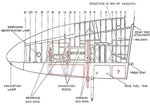- Thread starter
- #41
Chin radiators were probably marginally less efficient that the Spitfire's existing radiator set up. Cooling drag is slightly higher overall, and then you have the issues of increased frontal area and, crucially for the Spitfire, nose heaviness.
Not even the greatest Spitfire fans would say that plane's radiators were that good. As for cooling drag being slightly higher overall (for frontal/beard raditor) - why would that be the case; ditto for frontal area? The oil tank would need to be removed, probably under pilot, so that should balance things somewhat.
The clipped wings on the Spitfires actually increased drag at high altitudes, due to much more turbulent wing vorticies and induced drag.
Plus, they have less than desirable effects on climb rate, turn and handling above 20,000 ft.
Guess you're right about it.
LE radiators were slightly more efficient than either the chin or embeded wing radiators in terms of drag, but only marginally so. Napier put them somewhere between 4.5 and 6.5% better in terms of overall drag.
Okay - we could see some 5% increase in speed then - a 20 mph plus?
Where did PR Spits keep all their fuel?
IIRC they had full width leading edge tanks. Is there some what to use them and add 2 cannon, and 2 0.50s or another 2 20mms?
Use the PR wings as the base, while making room for the gun barrels? So instead of 2 x 66 IG, we have maybe 2 x 45-50 IG?
Were the PR wing fuel tanks protected/self-sealing?

